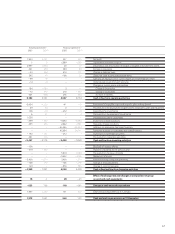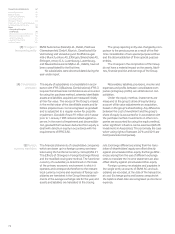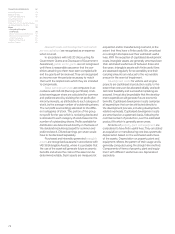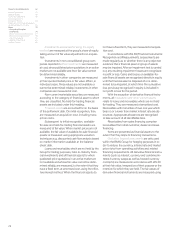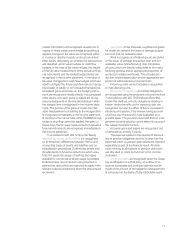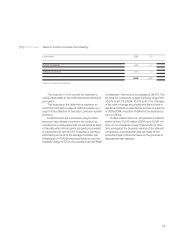BMW 2005 Annual Report Download - page 78
Download and view the complete annual report
Please find page 78 of the 2005 BMW annual report below. You can navigate through the pages in the report by either clicking on the pages listed below, or by using the keyword search tool below to find specific information within the annual report.77
market information and recognised valuation tech-
niques. In those cases where hedge accounting is
applied, changes in fair value are recognised either
in income or directly in equity under accumulated
other equity, depending on whether the transactions
are classified as fair value hedges or cash flow
hedges. In the case of fair value hedges, the results
of the fair value measurement of the derivative finan-
cial instruments and the related hedged items are
recognised in the income statement. In the case of
fair value changes from cash flow hedges which are
used to mitigate the future cash flow risk on a recog-
nised asset or liability or on forecasted transactions,
unrealised gains and losses on the hedging instru-
ment are recognised initially directly in accumulated
other equity. Any such gains or losses are recog-
nised subsequently in the income statement when
the hedged item is recognised in the income state-
ment. The portion of the gains or losses from fair
value measurement not relating to the hedged item
is recognised immediately in the income statement.
If, contrary to the normal case within the BMW Group,
hedge accounting cannot be applied, the gains or
losses from the fair value measurement of derivative
financial instruments are recognised immediately in
the income statement.
In accordance with IAS 12 (Income Taxes),
deferred tax assets and liabilities are recognised
on all temporary differences between the tax and
accounting bases of assets and liabilities and on
consolidation procedures. Deferred tax assets also
include claims to future tax reductions which arise
from the expected usage of existing tax losses
available for carryforward, where usage is
probable.
Deferred taxes are computed using enacted or
planned tax rates which are expected to apply in the
relevant national jurisdictions when the amounts are
recovered.
Inventories of raw materials, supplies and goods
for resale are stated at the lower of average acquisi-
tion cost and net realisable value.
Work in progress and finished goods are stated
at the lower of average acquisition cost and net
realisable value. Manufacturing cost comprises
all costs which are directly attributable to the manu-
facturing process and an appropriate proportion of
production-related overheads. This includes pro-
duction-related depreciation and an appropriate pro-
portion of administrative and social costs.
Financing costs are not included in acquisition
or manufacturing cost.
Provisions for pensions and similar obligations
are recognised using the projected unit credit method
in accordance with IAS 19 (Employee Benefits).
Under this method, not only obligations relating to
known vested benefits at the reporting date are
recognised, but also the effect of future increases in
pensions and salaries. This involves taking account
of various input factors which are evaluated on a
prudent basis. The provision is derived from an inde-
pendent actuarial valuation which takes into account
the relevant biometric factors.
Actuarial gains and losses are recognised, net
of deferred tax, directly in equity.
The expense related to the reversal of
discount-
ing on pension obligations and the income from the
expected return on pension plan assets are reported
separately as part of the financial result. All other
costs relating to allocations to pension provisions
are allocated to costs by function in the income
statement.
Other provisions are recognised when the Group
has an obligation to a third party, an outflow of re-
sources is probable and a reliable estimate can be
made of the amount of the obligation. Measurement
is computed on the basis of fully attributable costs.


